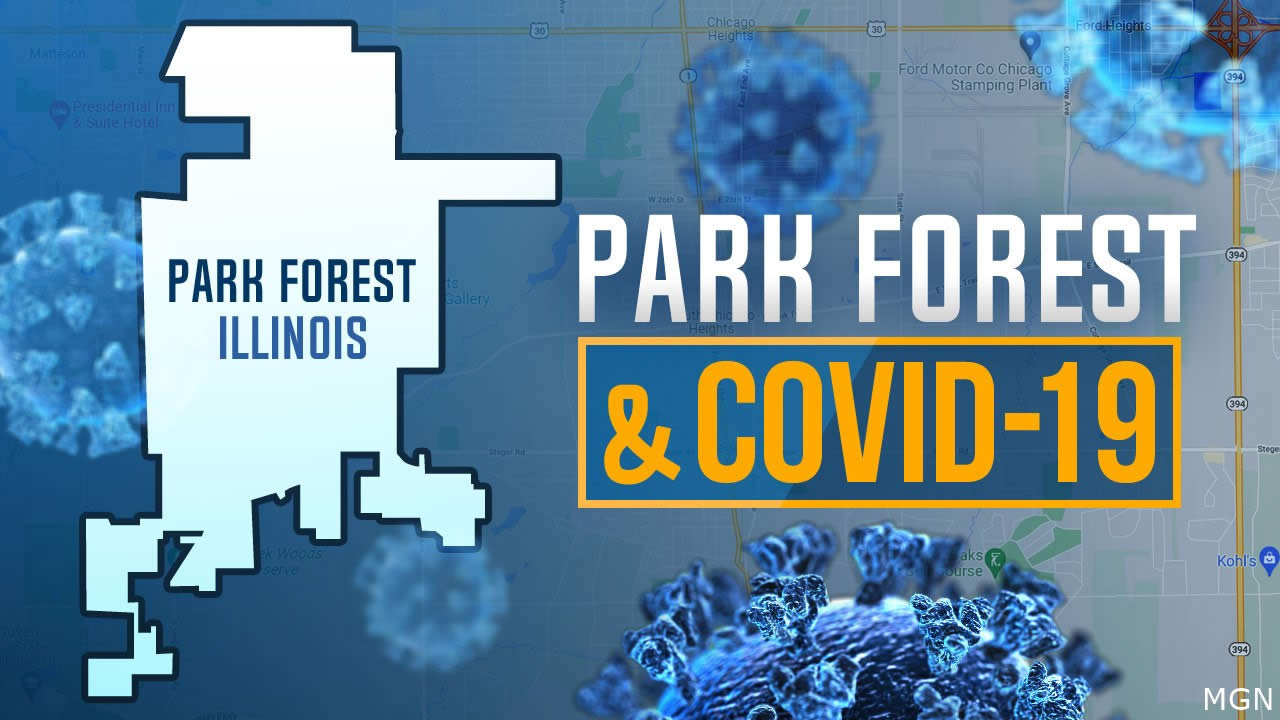
The latest numbers for 30 South Suburban towns, Cook and Will Counties, State of Illinois
Park Forest, IL-(ENEWSPF)- Park Forest still has the highest rate of confirmed SARS-CoV-2 (COVID-19) cases per 100,000 at 1,619.30. The Village has 347 total with 184 of those located at Ludeman Center. The Town of Cicero still has the largest number of cases with 1,231 and a rate of 1,467.42 per 100,000. All of this is according to data provided by the Illinois Department of Public Health.
South Chicago Heights has the third highest rate per 100,000 at 1401.30 with 58 cases for the tiny municipality of just over 4,000 people.
eNews Park Forest continues to track the number of cases and the rate per 100,000* cases for 30 municipalities in the South Suburbs.
The Will County Health Department reports 28 cases of COVID-19 in the Will County section of Park Forest as of May 3, 2020. This is double the number of cases since we last tallied numbers on April 28.
As of this writing on May 3, Chicago Heights has 278 cases, Steger has 49, Flossmoor 59, Richton Park 135, Olympia Fields 39, Sauk Village 69, Glenwood 78, Tinley Park 160, and South Chicago Heights has 58.
Harvey has 234 cases, Country Club Hills has 204 cases, Orland Park 238, Lynwood 88, Lansing 209, Homewood 181, South Holland 243, Calumet City 325, Markham 144, and Crete 90. Ford Heights now has 20 cases.
Of the 30 towns we track, Cicero remains alone with the highest number of cases, now at 1,231 with a rate per 100,000 at 1467.42.
Deceased from COVID-19
The number of deaths related to COVID-19 in the Cook County section of Park Forest remains at 10 since we last tallied comprehensively on April 28. The number of deceased from Chicago Heights is also unchanged at 13. Cicero lost 25, Richton Park 7, Matteson 12, and Country Club Hills 12. The number of deaths in Steger (Cook County) is also unchanged since April 28 at 3.
The City of Chicago has lost 1,044 people to COVID-19.
Ludeman Center Update
Parents & Friends of the Ludeman Center provided an update as of May 2, 2020:
“Ludeman has tested all residents at the Ludeman Center for COVID-19. The testing is based on recommendations from the infectious disease physician who is consulting with the Divisions of Developmental Disabilities and Mental Health. This will enable Ludeman to continue the best possible precautionary, clinical and medical programming and supports for the people they serve. Ludeman will notify families of the testing process and results.
The group received the following information from the Ludeman Center for the May 2nd COVID-19 testing results:
- Ludeman Residents: 184 tested positive. 146 tested negative. 14 pending results.
- Ludeman Staff: Unchanged – 68 tested positive.
- 35 of 38 occupied Ludeman Homes have individuals that have been tested for COVID-19.
Wellness checks are being conducted on staff members before reporting to their respective assignments, the group says.
Ludeman Center is in great need of the following supplies, the group notes:
- Disposable Stethoscopes
- Disposable Surgical Gowns
- Surgical KN95 Masks
- Oral or Temporal Thermometers
- Wall Mounted Hand Sanitizers – Holder and Sanitizer Supply
- Sanitizer Wipes, Disinfectant Spray
“If you are able to fulfill any of the above supplies to Ludeman, e-mail us at [email protected] and we will be happy to pick up or give you instructions to ship your donation,” Parents & Friends of the Ludeman Center says.
Projections
The Institute for Health Metrics and Evaluation (IHME) says the number of COVID-19 cases peaked in Illinois on April 17, but testing continues. Hence, the number of cases in the South Suburbs continues to rise. The IHME also says the peak death rate from the worst pandemic in anyone’s memory has also passed in Illinois.
IHME still projects that relaxing social distancing in Illinois may be possible after May 20, 2020, with containment strategies that include testing, contact tracing, isolation, and limiting gathering size.
“Since data can fluctuate daily, IHME uses the overall trend (rather than the single highest reported number) to identify a peak date of daily deaths,” the organization’s website notes.
IHME projections assume strict social distancing continues until infections are minimized and containment implemented.
Mask Requirement in Illinois Now in Effect
Gov. J.B. Pritzker’s stay-at-home order will continue in Illinois through the month of May. Additionally, he is requiring a “face-covering or mask” for all over the age of two under certain circumstances.
The Governor said:
Starting on May 1, any individual over the age of two and able to medically tolerate a face-covering or mask will be required to wear one when in a public place where they can’t maintain a six-foot social distance. Face coverings work and we need all Illinoisans to do their part here.
For our essential businesses, including manufacturers, we are issuing new requirements on social distancing and new caps on occupancy.
Again all of these things won’t take effect until May 1 – a week from tomorrow. And they are only minor modifications – what we can do safely – while keeping our stay at home restrictions in place as we manage through to the next phase.
This order was further modified to allow religious gatherings of up to 10 people.
Current COVID-19 Cases for Several South Suburban Towns
| Municipality | COVID-19 Cases | Most Recent Population Figures | Rate per 100,000 Population* |
| Calumet City | 325 | 37042 | 877.38 |
| Chicago Heights | 278 | 30276 | 918.22 |
| Cicero | 1231 | 83889 | 1467.42 |
| Country Club Hills | 204 | 16541 | 1233.30 |
| Crestwood | 63 | 10950 | 575.34 |
| Crete | 90 | 8117 | 1108.78 |
| Dolton | 220 | 23153 | 950.20 |
| East Hazel Crest | 7 | 1543 | 453.66 |
| Flossmoor | 59 | 9464 | 623.42 |
| Ford Heights | 20 | 2763 | 723.85 |
| Frankfort | 88 | 19178 | 458.86 |
| Glenwood | 78 | 8969 | 869.66 |
| Harvey | 234 | 25282 | 925.56 |
| Hazel Crest | 146 | 14100 | 1035.46 |
| Homewood | 181 | 19323 | 936.71 |
| Lansing | 209 | 28331 | 737.71 |
| Lynwood | 88 | 9007 | 977.02 |
| Markham | 144 | 12508 | 1151.26 |
| Matteson | 237 | 19009 | 1246.78 |
| Oak Forest | 112 | 27962 | 400.54 |
| Olympia Fields | 39 | 4988 | 781.88 |
| Orland Park | 238 | 56582 | 420.63 |
| Park Forest | 347 | 21429 | 1619.30 |
| Richton Park | 135 | 13646 | 989.30 |
| Sauk Village | 69 | 10506 | 656.77 |
| South Chicago Heights | 58 | 4139 | 1401.30 |
| South Holland | 243 | 22030 | 1103.04 |
| Steger | 49 | 9331 | 525.13 |
| Tinley Park | 160 | 49235 | 324.97 |
| University Park | 67 | 6958 | 962.92 |
| Combined | 5419 | 606251 | 893.85 |
*Numbers per 100,000 based on most recent population from US Census.gov or derived via formulat using rate per 100,000 population and COVID-19 cases as reported by Cook County. |
|||
The following chart will auto-update as we update our Google spreadsheet:
This chart might not appear on all mobile devices. It does not appear, for example, in the browser built into the Apple Facebook app.
As of May 3, 2020, there are a total of 16,356 confirmed cases of COVID-19 in suburban Cook County and 632 deaths. 125 congregate settings, such as long term care facilities or nursing homes, are reporting one or more confirmed cases. The data from Cook County includes all cases under the jurisdiction of the Cook County Department of Public Health (excludes Chicago, Evanston, Oak Park, Skokie, and Stickney Township). All numbers are provisional and subject to change.
As of this writing on May 2, Will County reports 2,868 known cases and 162 deaths.
Overall for the State of Illinois
The Illinois Department of Public Health (IDPH) on May 2 announced 2,450 new cases of coronavirus disease (COVID-19) in Illinois, including 105 additional deaths.
- Boone County: 1 female 80s, 1 male 80s
- Clinton County: 1 male 80s
- Cook County: 1 female 20s, 1 female 30s, 1 male 30s, 1 female 40s, 1 male 40s, 3 females 50s, 8 males 50s, 5 females 60s, 7 males 60s, 8 females 70s, 8 males 70s, 6 females 80s, 12 males 80s, 7 females 90s, 2 males 90s
- DuPage County: 1 male 60s, 1 female 70s, 2 females 80s, 5 males 80s, 3 females 90s, 2 males 90s
- Jefferson County: 2 females 90s
- Kane County: 1 female 70s, 1 female 90s
- Kankakee County: 1 male 70s
- Lake County: 1 female 70s, 1 male 80s
- McDonough County: 1 male 70s
- McHenry County: 1 male 60s
- Sangamon County: 1 female 70s
- St. Clair County: 1 female 50s, 1 female 90s
- Will County: 1 male 70s, 1 female 80s, 1 male 80s, 2 females 90s
Currently, IDPH is reporting a total of 58,505 cases, including 2,559 deaths, in 97 counties in Illinois. The age of cases ranges from younger than one to older than 100 years. Within the past 24 hours, laboratories have processed 15,208 specimens for a total of 299,896.
The Illinois Department of Veteran’s Affairs is reporting one resident at its LaSalle Veterans’ Home testing positive. Testing efforts are underway at the facility.
*All data are provisional and will change. In order to rapidly report COVID-19 information to the public, data are being reported in real-time. Information is constantly being entered into an electronic system and the number of cases and deaths can change as additional information is gathered. Information for deaths previously reported have changed, therefore, today’s numbers have been adjusted. For health questions about COVID-19, call the hotline at 1-800-889-3931 or email [email protected].
*Why Rate Per 100,000?
We found a clear explanation for viewing the rate of infections per 100,000 comes from Indiana University at Bloomington: “There may or may not be 100,000 residents in the county under review, but multiplying the result by 100,000 makes that rate comparable with counties with more than 100,000 or less than 100,000.”
“It is customary to use rates per 100,000 population for deaths and rates per 1,000 population for live births,” our source at Indiana University says.
So, none of the cities, towns, and villages we survey have 100,000 residents, but by using the rate per 100,000, we are able to compare apples to apples, so to speak, as if every town did have 100,000 residents.
eNews Park Forest will continue to track the effects the COVID-19 pandemic has on our region.








